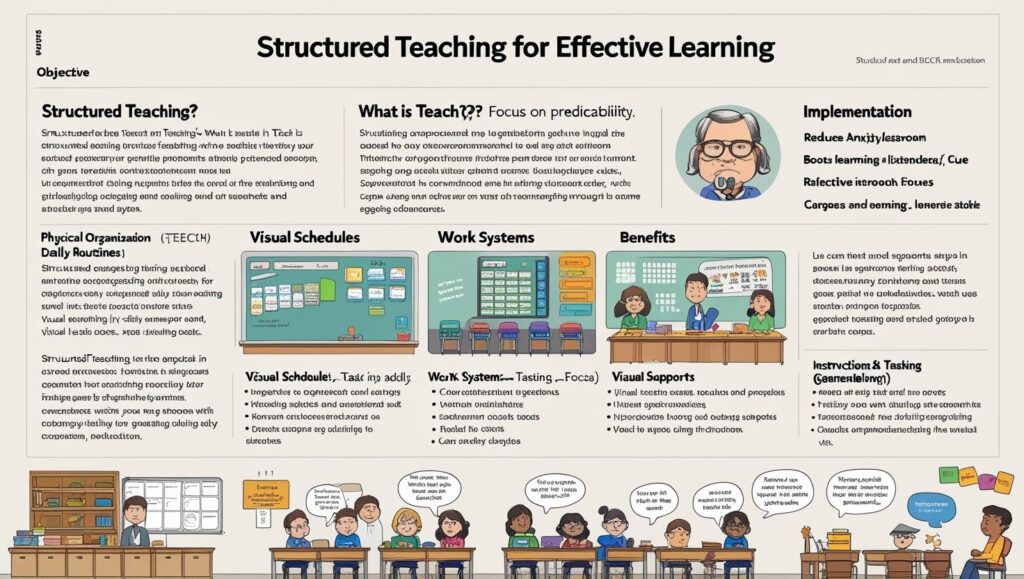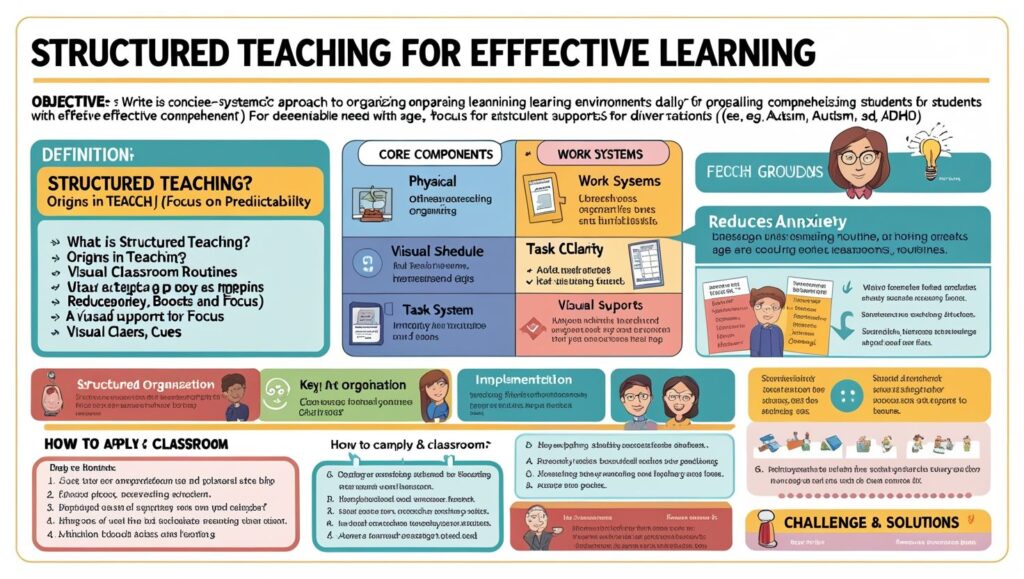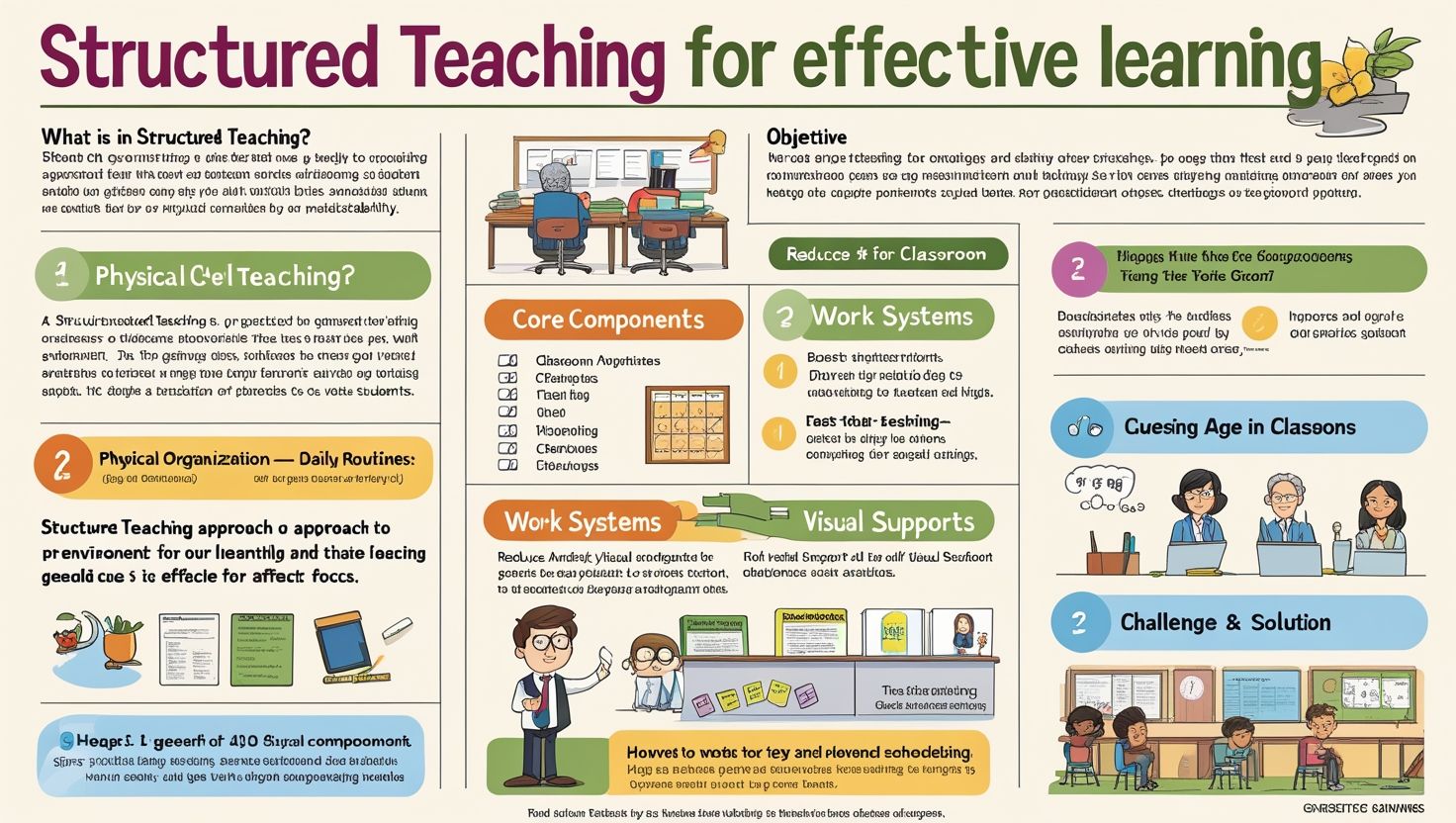Introduction
Structured Teaching for Effective Learning, Structured teaching is an instructional approach designed to create a predictable and organized learning environment. It is particularly beneficial for students with diverse learning needs, including those with autism spectrum disorder (ASD), attention deficit hyperactivity disorder (ADHD), and other developmental or cognitive challenges. However, its principles can be applied universally to enhance learning outcomes for all students.
This article explores the concept of structured teaching, its key components, benefits, implementation strategies, and its impact on student success. By the end, educators, parents, and caregivers will have a thorough understanding of how structured teaching can be utilized to foster an effective and inclusive learning environment.
What is Structured Teaching?
Structured teaching is a systematic method of organizing the learning environment to make it more accessible and understandable for students. Developed as part of the TEACCH program at the University of North Carolina, structured teaching emphasizes visual supports, clear routines, and individualized instruction.
The primary goal of structured teaching is to reduce anxiety and confusion by providing students with a predictable framework. This approach helps learners understand expectations, transition between activities, and develop independence.
Key Components of Structured Teaching
Structured teaching is built on four main components:
- Physical Organization
- The learning space is arranged to minimize distractions and maximize focus.
- Clear boundaries define different areas (e.g., workstations, play areas, quiet zones).
- Visual cues (such as labels and color-coding) help students navigate the environment.
- Schedules
- Visual or written schedules outline daily activities in a predictable sequence.
- Schedules reduce anxiety by helping students anticipate transitions.
- They can be individualized based on the student’s comprehension level (objects, pictures, or words).
- Work Systems
- Clear instructions are provided on what to do, how much to complete, when the task is finished, and what comes next.
- Tasks are broken into manageable steps.
- Work systems promote independence by reducing reliance on constant teacher prompts.
- Visual Structure
- Visual supports (such as diagrams, charts, and checklists) enhance understanding.
- Materials are organized systematically (e.g., left-to-right or top-to-bottom sequences).
- Visual instructions clarify expectations and reduce verbal overload.

Benefits of Structured Teaching
Structured teaching offers numerous advantages for both students and educators:
For Students:
- Reduces Anxiety: Predictable routines help students feel secure.
- Enhances Independence: Clear instructions minimize reliance on adult guidance.
- Improves Focus: Structured environments reduce distractions.
- Supports Diverse Learners: Adaptable for students with ASD, ADHD, and other learning differences.
- Encourages Task Completion: Work systems break tasks into achievable steps.
For Educators:
- Increases Classroom Efficiency: Organized spaces and routines streamline instruction.
- Reduces Behavioral Challenges: Clear expectations minimize frustration and meltdowns.
- Facilitates Differentiation: Easily adaptable for individual student needs.
- Promotes Consistency: Helps maintain structure across different settings (classroom, home, therapy).
Implementing Structured Teaching in the Classroom
1. Designing the Physical Environment
- Divide the classroom into distinct areas (e.g., reading corner, group work area, individual workstations).
- Use visual boundaries (e.g., rugs, tape on the floor, furniture arrangement) to define spaces.
- Minimize clutter and distractions (e.g., cover shelves, use neutral colors).
2. Creating Visual Schedules
- Choose the appropriate format based on student needs (objects, pictures, words, or digital apps).
- Place schedules in a consistent location where students can easily access them.
- Teach students how to use schedules through modeling and reinforcement.
3. Developing Work Systems
- Use structured task organization (e.g., folders, trays, or bins labeled with steps).
- Provide clear start and finish cues (e.g., “First-then” boards, timers).
- Gradually increase complexity as students gain confidence.
4. Incorporating Visual Supports
- Use visual instructions (e.g., step-by-step pictures for a science experiment).
- Implement visual timers to help with time management.
- Provide visual behavior reminders (e.g., “Raise hand to speak” posters).

Structured Teaching for Different Age Groups
Early Childhood (Preschool-Kindergarten)
- Focus on object schedules (e.g., a toy car symbolizes outdoor play).
- Use simple picture-based instructions.
- Incorporate sensory-friendly materials.
Elementary School
- Introduce written schedules for readers.
- Implement checklists for multi-step assignments.
- Use color-coding for subject organization.
Middle & High School
- Transition to digital planners or apps for schedules.
- Teach self-monitoring strategies (e.g., goal-setting charts).
- Provide graphic organizers for complex projects.
Adult Learners & Vocational Training
- Apply structured teaching in workplace settings.
- Use task analyses for job-related skills.
- Implement visual guides for independent living (e.g., cooking steps).
Challenges and Solutions in Structured Teaching
| Challenge | Solution |
|---|---|
| Resistance to routines | Gradually introduce structure with positive reinforcement. |
| Difficulty generalizing skills | Practice structured methods in multiple settings (home, school, community). |
| Limited access to visual materials | Use free digital tools (e.g., Canva, Boardmaker). |
| Over-reliance on prompts | Fade prompts gradually to encourage independence. |
Conclusion
Structured teaching is a powerful framework that enhances learning by providing clarity, predictability, and individualized support. Whether used in special education or mainstream classrooms, its principles help students thrive by reducing anxiety, improving focus, and fostering independence.
Educators and parents can implement structured teaching by organizing the physical environment, using visual schedules, developing work systems, and incorporating visual supports. With consistency and adaptation, this approach can transform the learning experience for students of all ages and abilities.
By embracing structured teaching, we create inclusive, supportive, and effective educational environments where every learner can succeed.
References
- Mesibov, G. B., Shea, V., & Schopler, E. (2005). The TEACCH Approach to Autism Spectrum Disorders. Springer.
- Hume, K. (2008). “Structured Teaching: Strategies for Supporting Students with Autism.” Intervention in School and Clinic.

5 thoughts on “Structured Teaching for Effective Learning”